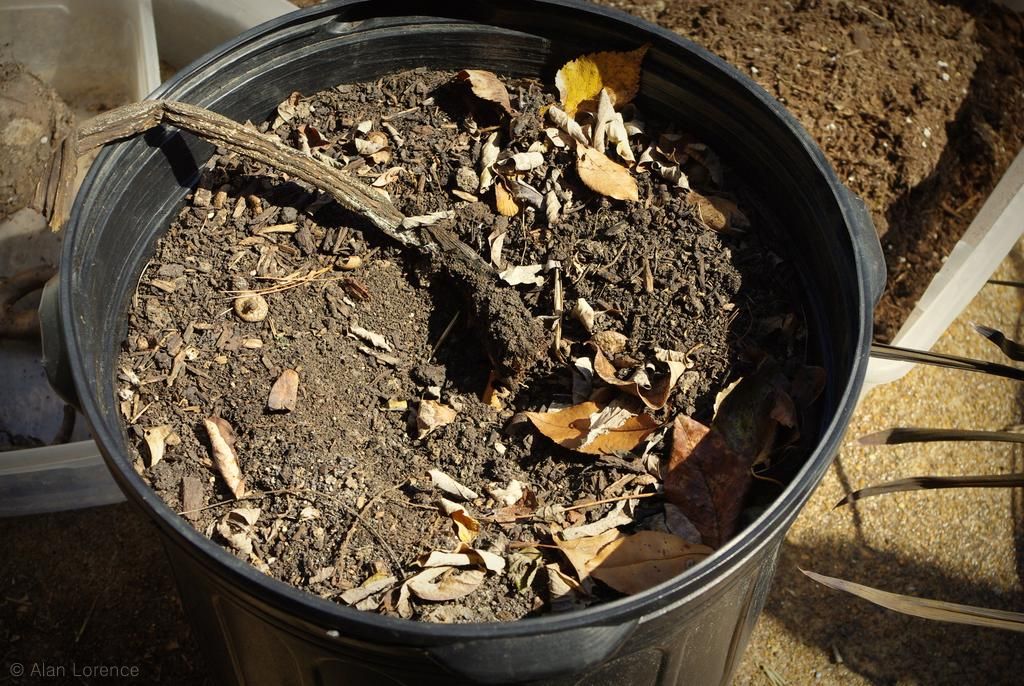Voodoo
>> Monday, March 31, 2014 –
discovery
I've been growing voodoo lily (Amorphophallus konjac) for a few years now, getting my first tiny tubers from my friend Mike. I've got a few planted in the ground next to the pond (not the best spot for them) but most of them grow in pots. It's strange that I can say "most of them" because I really only had one potted plant until last summer when Mike decided he was tired of growing these and gave a few more to me.
Although cold-hardy to zone 6 when in the ground, I move the potted specimens into the garage when the autumn cold kills the foliage, then just let the soil dry out. The dead stem shrivels and dies at some time during the winter, leaving a hole in the ground that enables you to peek in and see the tuber -- I just leave them there all winter, until I dig them out in the spring.
Which appears to finally be here! Warm, sunny weather yesterday (70ºF/21ºC) gave me the motivation to start pulling plants out of the garage, and I started with these. You can see the small tuber above, which is actually quite a bit larger than what I started with.
I started with something more like these "pup" tubers:
Similar to the way that many colocasia (elephant ears) will produce pups at the ends of fleshy stolons, voodoo lily multiplies the same way. I'll plant these up, trade them, or give them away. I've read that it's best to remove these in the spring instead of fall to prevent rot, but I do it now because it's less work, not because I'm worried about rot.
The next tuber was a plant I got from Mike in mid-summer. It was bigger than my plant, which naturally means the tuber would be bigger too -- and it was:
Here you can see the fleshy stolon which broke:
This is the part that broke off:
It's so bent because the pot wasn't quite large enough, and although it wanted to spread out it couldn't go very far.
This brings me to the final plant, which Mike gave to me at the end of the growing season.
It was quite an impressive thing, probably 4' (1.2m) in height or more, with a huge "umbrella" of foliage. Remember, big plants mean big tubers...
...and this one is massive! Much larger than my hand!
It's starting to grow already:
This may mean that it is going to bloom before the foliage starts growing. That would be impressive, but since the huge flowers smell of rotting flesh (to attract the flies that pollinate it) I can't say I'm looking forward to it.
Here's another look at all of them for comparison:
Those are my Felco 8's for reference. That big one is huge!
I'll plant it in one of my largest pots this year -- I wonder how big it will be next year?
One of my favorite things about spring is that I get to rediscover all of these forgotten treasures, plants that were tucked away into the garage nearly almost forgotten about. Now it's time for them to grow again, and it's exciting!
.













I have several large konjacs blooming in basement now, awesome but stinky :) The tubers can grow to around 30 pounds. I'm an amorphophallus addict, my collection is up to around 30 different species :)
30 pounds! How many years does it take to reach that size? What is your favorite amorphophallus species? I like this one because it's easy. :)
I wonder if the 30lb issue is putting you off. Is the thought of a stinky bloom putting you off? Probably not. Always special to see new growth on something you have kept over the winter.
I love Amorphophallus konjac. I have three or four in the ground and they come back every year. None of them have bloomed yet though. Can't wait to see what your big one will do this year!
There are many I love, but my favorites are Amorphophallus maxwellii and a dark petiole form of konjac called 'nightstick'
with a good source of Phosphorus, tubers can quadruple its size in one season. 5+ years to reach that size.